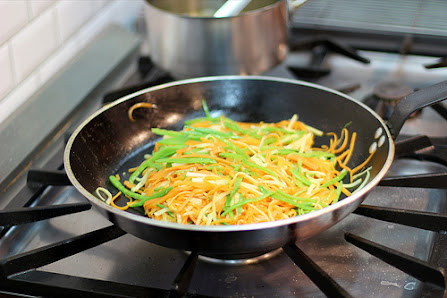from
Behind the French Menu
by
Bryan G. Newman
behindthefrenchmenu@gmail.com
Le Chambérat Fermier
Le Chambérat is a creamy but not spreadable, mild, 30% fat cow’s milk cheese. It is made in unpasteurized and pasteurized versions. The cheese has a smooth, light brown natural rind with a pale ivory to yellow paste which is dense and soft to the touch. The unopened cheese has a light smell of the caves where it matured becoming nuttier as it ages.
The two sizes of Chambérat cheese.
Le Chambérat comes in two sizes, the larger is the Chambérat Fermier or Gros Chambérat and weighs 1.40 kg (3 lbs) in a wheel 18 cm (7”) in diameter by 5cm (2”) high. The smaller size is called Chambérat Laiter or Petit Chambérat and weighs 600 grams (1.3 lbs), it comes in wheels 14 cm (5.5’ ) in diameter by 3cm ( 1.2”) high.
(The word Fermier in the name Chambérat Fermier indicates a farm made cheese and the word Laitier in the name Chambérat Laitier indicates a cheese made in a dairy. However, apart from real Chambérat aficionados, I do not think that many of us can tell the difference.
The Chambérat Fermier, a 1.4 kilo (3lb) cheese.
Chambérat cheese on French menus:
Salade de Chambérat: Salade, Toasts de Chambérat, Noix, Tomatoes, Œufs – Salad Chambérat; a green salad, toasts with grilled Chambérat, walnuts, tomatoes, and eggs.
Trouflaille Bourbonnaise (Tourte aux Pommes de Terre, Lardons et Chambérat) - Trouflaille Bourbonnaise, is a traditional Bourbonnaise dish. A potato pie made with bacon pieces and Le Chambérat cheese.
Aging Chambérat cheese.
The cheese is aged for a minimum of eight weeks and during that period the wheels are washed and turned. At eight weeks the cheese has a light hazelnut flavor, and that flavor intensifies in older cheeses. If you buy a whole cheese, ask how long it has been aged; many fromageries, cheese shops, have their own cellars where they age cheeses so they may offer their clientele different tastes. Additionally, Chambérat is only produced in the spring and summer months from March to September when the cows can graze freely. If you buy a cheese in January at its youngest it would be five months old. Old cheeses, up to 12 months, are sometimes available.
Chambérat’s name
The cheese’s name comes from the village of Chambérat in the department of Allier in the region of Auvergne-Rhône-Alpes. Chambérat and the area around has its own micro-climate which makes for richer grasses, wild herbs, and flowers. The actual production is close to the nearby villages of Archignat, 10 km (6 miles) away, and the village of Treignat 13km (8 miles) away. The three villages involved are traditional French villages with small populations, but they serve all the farms around them and there are hotels, B and Bs, restaurants, butchers, bakers, and everything an active community needs.
Hotel Chambérat
The production of Chambérat
Le Chambérat was popular from the 16th century onwards, but after WWI the number of farmers dropped and the population began moving to the city. Then came WWII and economic depression; come the 1960s the cheese was only made by a single farmer. Le Chambérat was brought back from extinction and popularized by three farmers and a dairy. The cheese is perfectly suited for French tastes and not expensive. Today, Le Chambérat is generally available all over France.
Aging Chambérat cheeses.
Bourbonnais
The old province of Bourbonnais has many local cheeses with the most famous cheese being the Saint Nectaire AOC/AOP. Saint Nectaire has a slightly different taste but a similar method of production. Apart from these two cow’s milk cheeses, the old province of Bourbonnais has three other famous product’s:
The Red Label.Charolais Lamb - Agneau Charolais du Bourbonnais.
The AOP Charolais Bourbonnais Goat’s Cheese - Charolais AOP.
The Charolais Bourbonnais Beef Cattle - Le Bœuf Charolais du Bourbonnais AOP.
Manufacturing Chambérat cheese.
While the Chambérat is aged, it is a quickly made cheese. Its method of manufacture, like many local cheeses, means the rennet is added immediately after milking. The reason behind the cheese’s fast manner of production dates back over 200 years when the owners of the great estates took a significant amount of the farmers’ output for rent. So the farmers made some of their cheeses quickly and then hid them while they aged.
The Roman bridge
8 km (5 miles) from Chambérat close to the village of Huriel,
La Foire de la Chambérat - The Chambérat Fair
The annual fair held in Chambérat is held on the first Monday following August 15th and is not only for cheese. The fair draws thousands of people and more than 200 exhibitors where you can buy horses, donkeys, melons and of course, Chambérat cheese.
For more details on the Chambérat fair click on or copy/paste the website below: The page is in French but easily understood with the Google and Bing translate apps.
You may also contact the Mairie, the Chambérat town hall, but have a French speaker handy, at +33 4 70 06 31 13, Fax +33 4 70 06 35 88.
Connected Posts:
Searching for the meaning of words, names or phrases
on
French menus?
Just add the word, words, or phrase that you are searching for to the words "Behind the French Menu" and search with Google. Behind the French Menu’s links include hundreds of words, names, and phrases that are seen on French menus. There are over 470 articles that include over 4,000 French dishes with English translations and explanations.













